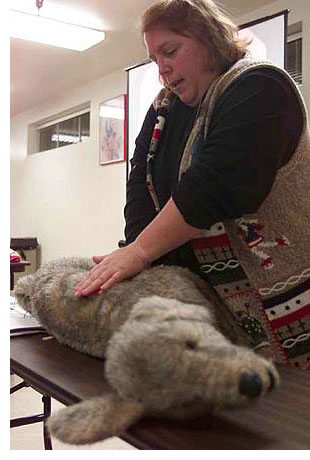 By Lindsay Barnett for the Los Angeles Times PhotoCredit: Myung J. Chun
By Lindsay Barnett for the Los Angeles Times PhotoCredit: Myung J. Chun
Study shows most pet owners would attempt CPR on their dog or cat. But what about other emergency preparedness?
Although most pet owners say they’d attempt doggie- or kitty-CPR to save an animal in danger, many are unprepared to deal with a wide range of other pet-related emergencies, according to a new poll conducted jointly by the Associated Press and Petside.com.
The poll, conducted Oct. 1-5 by GfK Roper Public Affairs & Media, utilized telephone interviews (both cellphone and landline) with 1,166 pet owners nationwide. Of those, 58% said they would be at least somewhat likely to perform CPR on a pet in need. (That figure is an average of dog owners, of which 63% said they would try to perform CPR, and cat owners, of which 53% gave the same answer.) Additionally, female pet owners were statistically more likely to attempt CPR on their pets, with 65% of women and only 50% of men saying they would try the technique.
“If people value their pets like a family member, they should know how to do CPR, just like they would for their kids. In disasters, pets get hurt and run into debris and all kinds of things,” Mark Solnick, director of emergency preparedness and response for the Red Cross of Santa Monica, told the Associated Press of the findings.
Both the American Red Cross and a number of private organizations offer pet first aid and CPR classes. Fortunately for Angelenos, one of these, Sunny-Dog Ink, offers seminars right here in Los Angeles.
Despite the generally favorable CPR statistics, the poll found emergency preparedness lacking among pet owners in several other key areas. Fifty-four percent of those interviewed said they did not have a fire evacuation plan for their dog or cat, and only 20% kept a stocked pet first-aid kit in their home. The Associated Press reports on a few other troubling trends:
And the survey revealed frequent reporting of dangerous practices that can lead to accidents and injuries. For example, a quarter of pet owners, including 30% of dog owners and 22% of cat owners, give their pets bones from table scraps, at least sometimes.
Sixty-two percent of dog owners and a third of cat owners let their pets ride in their cars unrestrained, rather than placing them in a special pet carrier. And 11% of pet owners sometimes leave their pets unattended in a car or truck.
A few more interesting statistics from the new poll: Seventeen percent of those interviewed said that a pet had been bitten or attacked by another animal (9% said their pet had been the attacker in such an incident, and 5% said their pet had bitten or attacked a human); 16% said their pet had experienced an allergic reaction; 7% said their pet had consumed poisonous material; and 11% said they’d had the agonizing experience of having a pet hit by a car.
The American Veterinary Medical Assn. offers a handy, printable list of items that should be kept in a pet first-aid kit; among them are phone numbers for the pet’s regular veterinarian as well as an emergency vet clinic and the animal poison-control center (888-4ANI-HELP); gauze; nonstick bandages, towels or other cloth as well as adhesive tape to secure cloth in place; milk of magnesia or activated charcoal for use in the event of poisoning; hydrogen peroxide; and a thermometer. For the full list, check out the AVMA’s website.

Yes I sure would,I love them.
I would do anything to save their life.
I AM EXTREMELY THANKFUL FOR THIS LIFE SAVING INFORMATION AND THE LINK THAT ENABLED ME TO VIEW THE PROPER CPR TECHNIQUES.
THANK YOU DOG FILES!!! 🙂
Thanks for spreading the word on pet safety. I attached two websites below that may be helpful. The first website is a picture description of HOW to do CPR for your pet. Hopefully you'll find this useful, but in reality, you should take a pet first aid CPCR course!
http://www.the-happy-dog-spot.com/dog-CPR.html
The second website is for information on a PET POISONING first aid kit:
http://www.petpoisonhelpline.com/PetCareTips/Pe…
I wanted to make you aware of another important resource out there also – Pet Poison Helpline is an additional Animal Poison Control Center, and it's one of the most cost-effective animal poison ($35/case vs. ASPCA's new $60/case) controls out there nowadays. Unfortunately, because animal poison controls are not federal- or state-funded, there is a fee to allow the service to be run 24-7. We provide a similar service, but have the added benefit of veterinary specialists (in internal medicine and emergency and critical care) as part of our staff. You can always call 1-800-213-6680 if you ever have a problem. Thanks for spreading the word!
Dr. Justine Lee, DVM, DACVECC
Associate Director of Veterinary Services
http://www.petpoisonhelpline.com
http://www.drjustinelee.com
I would not hesitate for a second! We took classes to learn proper procedureand what signs to look for! Our dog would do anything for us, so why would we not reciprocate?
Other dogs…..hmmm…I guess I might , but, golly, one never knows until faced with the situation.
I would not hesitate for a second! We took classes to learn proper procedureand what signs to look for! Our dog would do anything for us, so why would we not reciprocate?
Other dogs…..hmmm…I guess I might , but, golly, one never knows until faced with the situation.